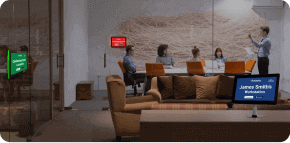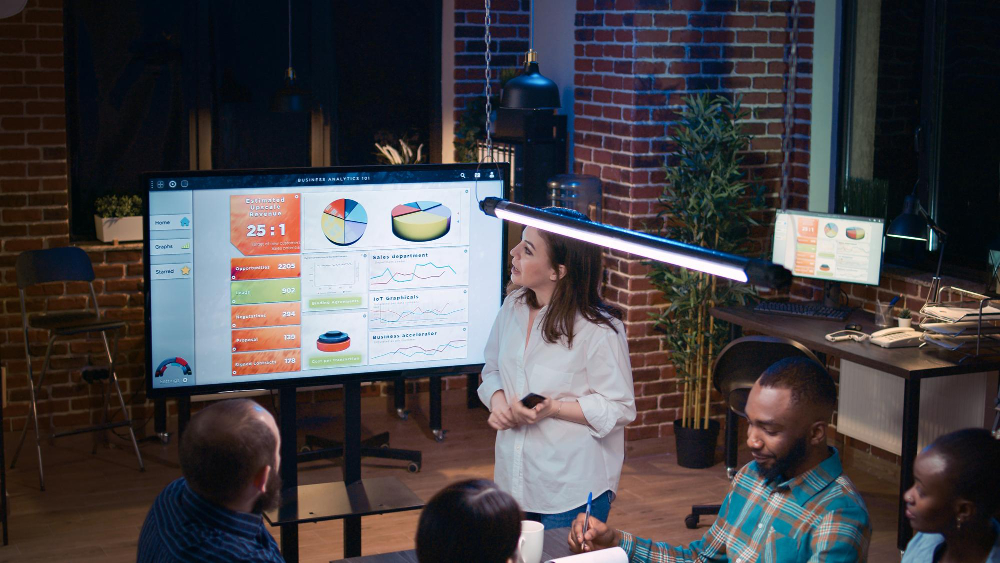Blog

Best Way To Run Hybrid Meetings and Workshops
The work environment in modern workplaces is known for its dynamic setups. Hybrid meetings and workshops have become the norm, especially after the pandemic. The hybrid setup was the best option when it was a struggle to make in-person gatherings due to capacity limitations. And pushing the limits out of this struggle is still possible thanks to its concept of combining in-person and virtual participants.
However, running this setup requires careful planning, the right technology, and a better understanding of virtual and in-person attendees’ needs. As this setup leaves a promising impression, here is a further discussion on how it plays its role for companies and organizations.
Introducing Hybrid Meetings and Workshops
As mentioned in the beginning, hybrid meetings and workshops are all about mixing in-person and virtual participation. It is a modern solution that offers flexibility and inclusivity for an office or organization that practices a hybrid setup.
However, with this kind of setup, it will take the management an extra effort to provide a seamless experience that everyone will love. Meticulous planning, choosing the hybrid meeting technology, and fostering an inclusive environment are some of the few things that can make it successful and effective.
Hybrid meetings bridge the gap between remote and in-person attendees. To simplify, they are an outlet for organizations to reach a wider range of talents and perspectives. The hybrid model supports various needs, including accommodating remote employees, reducing travel costs, and enhancing work-life balance. As the global workforce becomes more distributed, mastering the hybrid approach becomes essential for maintaining effective collaboration and productivity.
How to Set Successful Hybrid Meetings and Workshops
1. Always plan ahead of time.
Have a clear goal and agenda.
Like any other meeting, the hybrid one also needs a clear objective and well-structured agenda. Ensure that this matter reaches the participants well in advance. It will save everyone’s time, as it will give them the right expectations and what to prepare appropriately. The management can now also guarantee not to mix presentations, discussions, and interactive activities to keep all attendees engaged.
Choose the Right Hybrid Meeting Technology
Invest in software solutions like video conferencing tools and other collaboration platforms. What makes a hybrid meeting different from the usual is the consideration of using advanced technology to lessen the gap between the remote and in-office audiences. Get the ones that can ensure that it supports some of the essential operations for the meeting, such as screen sharing, breakout rooms, or real-time collaboration.
2. Optimize the most out of physical and virtual setups.
Physical Setup
First, ensure that the in-person attendees get the appropriate table and seat setup, whether for a meeting or workshop. For instance, setting the arrangement with a U-shape or circular seating arrangement can help push everyone to join discussions. It is also the best way for everyone to share the main screen.

Optimizing the best out of a physical setup begins with choosing the best seating arrangement. Also, remember to equip the room with high-quality audio-visual equipment, including the following, to ensure virtual participants are easily seen and heard:
- Microphones
- Speakers
- Cameras
- Large Screens
Virtual Setup
There should also be a commendable setting for the virtual participants, and it begins by giving access to all the necessary materials and instructions beforehand. The management should see those hybrid meeting equipment to test ahead of time.
For instance, the host room should ensure that they have reliable internet connections, and in case of disconnection, they will have a backup solution. Equipment should also be ready for the meeting, such as:
- Camera
- Microphone and other hybrid software solutions
Lastly, encourage everyone to join the meeting or workshop from quiet or well-lit locations. For that, they can avoid distractions and fully focus on the event.
3. Always to facilitate an equal participation.
Assign Roles
Equal participation is crucial for any meeting or workshop, especially in the case of a hybrid setting where the remote ones will need help to connect with the ones in the venue. Hence, the management should assign a facilitator to guide the meeting to ensure everyone gets equal participation. That person should be there for everyone to stay on track.
It is also essential that the management have reliable tech support that can handle any technical issues. Lastly, it is also crucial that there is a moderator who can manage chat and Q&A from the virtual participants. These roles help maintain a smooth flow and ensure that in-person and virtual attendees are engaged.
Inclusive Engagement
The activities or discussions should address roles that maintain inclusivity and promote participant interaction. For instance, if something needs a consensus discussion, the host can hold polls that allow everyone to join.
To make it inclusive for everyone, the host should do it with collaborative tools like virtual whiteboards or online polls. Always begin in a space where in-person and virtual attendees can give input and feedback. That way, no one is left behind and ensures everyone feels included.
4 Make the best communication and interaction.
Utilize multiple hybrid software platforms.
The ideal way to make the best communication between the remote and on-site participants is to have multiple channels where they can connect. Although there should be a primary platform for everything, utilizing different communication hybrid platforms can help them broaden their options.
For instance, from the primary video conferencing platform, they can also have an option for instant messaging. That way, it allows the participants to do the following:
- Choose how to ask questions
- Share ideas; or
- Provide feedback without interrupting the main discussion or letting them express their thoughts in their most comfortable choice
5. Have solutions for possible technical issues.
Reliable Internet Connection
As mentioned earlier, the reliability of the internet connection is crucial as this allows the remote participants to keep connected with the venue. The management should ensure a strong and stable internet connection for in-person and virtual participants. For in-person meetings, provide a dedicated Wi-Fi network for participants to use.
On the other hand, virtual attendees should also be encouraged to use a wired connection if possible or position themselves close to their Wi-Fi router. That way, everyone will be on the same track.
Ensure Backup Plans
Backup plans are essential with hybrid meetings since anything can happen, especially in technical aspects. The management should also have backup devices or a solid plan for proceeding from reliable internet if the existing hybrid meeting solutions fall short. Also, remember that effective communication is essential to address these issues. Organizers should connect to ensure everything goes in place, whatever may happen.
6. Maintain the engagement and focus during the event.
Take Short Breaks
Like any other workshop, ensure that there is still a short break for both in-person and remote participants. Especially if the workshop is a whole-day event, take some short breaks so that everyone can freshen their minds from time to time and stay focused.
The management can either take a 45-minute session followed by a 10-minute break. It is also beneficial for participants to connect besides the activities for the workshop. A small chitchat can start a good connection to one another.
7. Summarize Everything and Gather Feedback
Summarize, Share, and Gather Feedback
After finishing everything, there is always a clear summary of everything that happened. For instance, in a meeting, summarizing the key points, decisions, and action items that will help the management see at the end of the day and in future use. Also, include any relevant documents or recordings of the sessions. That way, it reinforces the management’s goal of having a good outcome and ensures everyone is on the same page.
Lastly, it is essential to always have feedback from the participants. That way, the management can analyze and determine if the workshop or meeting is successful. That way, they can make improvements or see what aspect of the hybrid events is worth maintaining.
The Advantages of Hybrid Meetings and Workshops
A successful hybrid meeting offers promising advantages, including enhanced flexibility, inclusivity, and productivity. Learn further about the setup’s critical benefits to companies and organizations.
#1. It Enhances Flexibility
One of the known advantages of hybrid meetings is that they bring flexibility to the company or organization. Participants from anywhere can join, whether they want to participate at the venue, at home, or even travel.
The flexibility allows the workshop or meeting to accommodate whatever the time zones and schedules. Hence, bringing a diverse team to one event makes everything much more manageable. As a result, organizations can hold convenient meetings or events for the participants. Also, they can reduce scheduling conflicts while improving overall attendance.
#2. It is Cost-Effective
Hybrid meetings also reduce the need for travel and accommodation expenses. It is a given fact that in-person meetings and workshops will require costs like flights, hotels, meals, and transportation.
However, this can be reduced thanks to hybrid meeting solutions, where virtual participation is possible. On the other hand, organizers can save money while achieving their objectives. Whether it is a small or big event, saving budget is possible.
#3. It Upgrades Accessibility
Hybrid meetings allow a more comprehensive range of participants. So, instead of just settling on how much capacity a venue can hold, they can now connect the event with remote participants.
The hybrid meeting equipment allows the organizers to invite participants worldwide despite the geographic locations. It will save them resources as travel is unnecessary, and they can invite guests on the same event day. Hybrid meetings and workshops make it open to a global audience.
#4. It Fosters On-trend Collaboration and Engagement
Using hybrid meeting equipment is one step towards showing how an event, like a meeting or workshop, follows the trend. The hybrid setting itself is advanced on its own.
The organizers should use advanced interactions, such as the following, to connect and allow in-person and remote attendees to engage:
- Polls
- Q&A Sessions
- Break-out Rooms
In addition, what makes it more on-trend is its support for real-time feedback and data collection. This hybrid meeting equipment enhances everyone’s responsiveness, regardless of their location. So, for anyone who sees the potential of a hybrid setup, being informed more about the real-time function of any hybrid equipment can be a game-changer.
#5. Event Continuity and Resilience
Another advantage of a hybrid setup for workshops and meetings is it is on the go. It supports adaptability, meaning that if there are any unforeseen circumstances like travel restrictions or health concerns, the event can continue. For instance, during the pandemic, online conferences have become a norm.
With the help of hybrid meeting equipment, institutions and businesses could hold meetings and discussions regardless of location. What makes hybrid settings beneficial, from that time up to today, is that they can scale up or down based on the number of remote attendees without the logistical challenges of accommodating everyone in a single location.
#6. Extend the Network and Opportunities
Another thing that makes the hybrid format ahead of time is the access to extending networks and opportunities. Think about how a typical workshop or seminar happens – one can only create new peers depending on who was at the event.
The venue’s capacity limit is enough for one to have a limited reach. However, in the case of a hybrid setup, an in-person participant can also connect to remote ones. In another scenario, if the event caters to an international audience, it also allows one to communicate with foreign participants where they can also make new connections. Thus, it is also one way towards new opportunities.
#7. Advanced Data Collection and Analytics
The advantage of a standard meeting and workshop from a hybrid setting is the presence of technological solutions. From software to equipment, organizers can have a better way of collecting data and analyzing it.
Instead of manually recording event information, organizers can now utilize digital tracking – from attendance, participation levels, and engagement metrics, all of which are accessible through the hybrid software. Hence, the organizer can also formulate their insights more reliably and efficiently. These insights will help them realize the event’s success and will guide them in future event planning.
The Future of Hybrid Meetings for Office and Organizations
Since the pandemic hit the world, mixing in-office and remote settings has dramatically benefited several industries and institutions. As its advantage has become ideal in strengthening and improving productivity, this meeting format has become a flexible and go-to approach for organizers. As technological innovations are also growing, hybrids will continuously become the norm choice for planners.

In the future, expect that hybrid meetings can even upgrade their virtual options of pre-recorded presentations or live-streamed keynotes that are supplements for the core of events. Also, more hybrid technological solutions will focus on upgrading the virtual experience to a more immersive and engaging one. See more advancements in Augmented Reality (AR) and Virtual Reality (VR), which will help give remote participants a closer realistic presence. Hybrid meetings will continuously exist and improve to cater to a broader audience, where anyone anywhere can join.
Tips You Need to Know About Improving Hybrid Meetings
1. How do we ensure a secure and private meeting environment for in-person and virtual attendees?
It is essential to remember that security is crucial in meetings, especially when dealing with sensitive discussions. If a company or an organization is doing a hybrid one, it is vital to prioritize access control. As it deals with in-person and virtual audiences, it can be more complex than it used to be. Organizers can secure the meeting space using unique and complex passwords for virtual attendees while ensuring that in-person participants are checked and guarded. Remember always to have encryption for data and communication.
For virtual meetings, utilize platforms with waiting rooms and host controls to manage entry. In-person, limit attendees and collect sign-in sheets for accountability. Finally, always have clear and established guidelines for information sharing. There should be enough room for reminders to maintain confidentiality. Hence, these measures can create a safe space for sensitive discussions.
2. How can an overall meeting culture be adapted to accommodate a hybrid work model?
As managements adapt to a hybrid work model, the meeting culture needs an overhaul to ensure everyone feels included and productive. Hence, one must prioritize delivering clear agendas and objectives where both in-person and remote participants contribute. Utilize technological solutions to make this possible.
For instance, recording meetings allows those attending asynchronously to stay informed while encouraging pre-meeting document sharing and streamlining discussions. On the other hand, for better interaction, consider using collaborative documents or discussion boards for non-urgent topics. That way, the management can create a meeting culture that values everyone’s time and fosters a thriving hybrid work environment.
DeskFlex: A Solution Supporting Hybrid Workshops and Events
If anyone wonders what hybrid workplace solution can make a hybrid event possible, DeskFlex is here to save the day. This technological advancement has been here for years and is known for its reservation functioning. Online booking and setting are essential in hybrid meetings, especially at the end of organizers.
One of the usual challenges in setting a hybrid meeting is the room reservation, or if it is a workshop, participants will need to book a space for themselves. DeskFlex is a solution that allows participants to make either an on-the-spot booking or an advance reservation for the event. However, this is possible if the venue or the company uses the hybrid software. Hence, it is no wonder that most hybrid offices can also set up hybrid meetings.
DeskFlex is a comprehensive hybrid solution that offers more than the booking aspect. To learn more about this advancement, one can visit www.deskflex.com.



















































 Support
Support  Demo
Demo  Blog
Blog 



